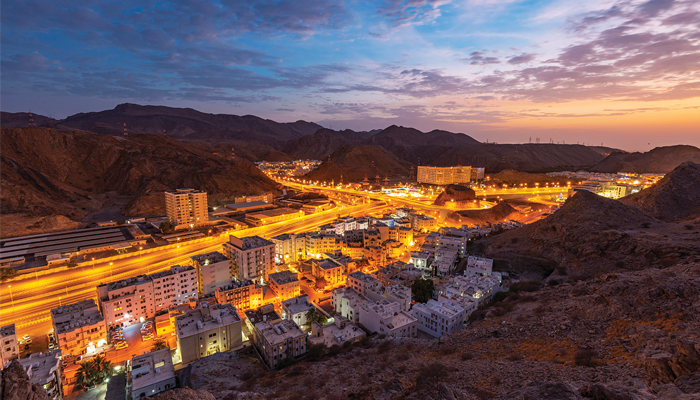
Muscat: Seven strategies to plan Oman’s cities, build better communities, and design a sustainable country have been drawn up by the Ministry of Housing and Urban Planning.
The creation of flexible and liveable cities and communities, preservation of Omani identity, climate change response and mitigation, protecting and monitoring the environment, achieving food security and efficient water resource management, finding alternative and sustainable means of transportation, and economic diversification and growth in each governorate based on sustainable resource use, harnessing renewable sources of energy, and efficient water and waste management are the seven objectives listed under the Urban Strategy.
Dr Hanan Amer Al Jabri, the Director General of Urban Planning at the ministry, said, “The Urban Strategy is the main engine for all development sectors and a road map to guide urban growth over the next twenty years. This is based on sustainable urban planning characterised by flexibility and set to deal with the national and global variables and developments, to achieve a balance concerning the dimensions of sustainable social, economic and environmental development.”
“It primarily seeks to achieve balanced urban development in all governorates, by providing guidance to growth through a series of gateways and centres identified by the strategy,” she said. “These population centres will help achieve and guide economic growth in each governorate, contribute to the availability of employment opportunities, and provide services and facilities to reduce internal migration.”
A major part of the strategy is the setting up of ‘greater cities’ that will help provide employment opportunities and infrastructure in alignment with the expected economic and population growth in these cities. These will then integrate with their neighbouring communities.
As a result of this plan, cities such as Greater Muscat, Greater Salalah, Greater Sohar, and Greater Nizwa have been planned for. Meanwhile, Duqm shall continue to develop in accordance with the rate of its expansion.
While major regional towns such as Khasab, Rustaq, Buraimi, Ibri, Sur and Haima will work as administrative centres for governorates, creating job opportunities in their respective regions. Along with the required facilities, areas such as Barka and Suwaiq are to be designated regional economic centres, with important functions, owing to their strategic locations.
They too will offer a variety of employment opportunities and administrative services for communities located within their jurisdiction. The strategy, explained Al Jabri, is based on assuming Oman’s population reaches between 7.1 and 7.5 million people by 2040, alongside a GDP growth of three to five per cent.
This increased GDP will be achieved through economic zones. Five free zones in the country will improve the country’s competitiveness, attract foreign direct investment, increase the efficiency of the business environment, improve economic performance, increase the contribution of GDP to 10 per cent, and expand the presence of skilled workers in the private sector.
“Achieving economic growth and prosperity revolves around non-oil sectors in the governorates and the efforts to strengthen and develop them based on the potentials of each governorate, namely education, innovation, tourism and manufacturing industries, in addition to logistics, finance and services,” said Al Jabri.
“The Urban Strategy pays attention to the potential impacts of climate change and has put in place precautionary measures to reduce expected losses, adapt to necessary changes that may occur during the preparation and implementation of plans and projects, and assess all necessary strategies and plans in terms of impact on sustainability, in terms of its various social, economic, environmental and cultural dimensions,” she added.
A major part of a sustainable, circular economy involves efforts to reduce material and energy waste through their reuse and recycling, instead of dumping. This shall reduce waste, gas emissions and raw material depletion by 70 per cent, contribute to the creation of economic and investment opportunities, focus on renewables as a main source of energy, through projects that will contribute to 62 per cent of the required amount of clean energy.
An important component of the Urban Strategy is to preserve Oman’s natural and cultural heritage, and make sure the country’s diverse flora and fauna are conserved for future generations, said Dr Thuraiya Saeed Khamis Al Sariri, the Assistant Director for Nature Conservation at the Environment Authority.
“This is to be achieved through the establishment of a network of natural reserves, the provision of infrastructure and teams necessary to preserve the natural heritage outside protected areas, and the identification and classification of important environmental and heritage resources,” she further added.
“These must be integrated into the urban development process, while possibilities of economic investment must be looked at, all the while continuing to preserve them for future generations,” she added.
Areas of natural beauty that also have economic and cultural value as well as important natural resources will be designated special areas of nature. Those who set up businesses linked to these areas will need to make sure they follow the policies laid down for their conservation.
So far, five terrestrial zones, spanning a total of 75,000 sq.km of Oman’s land have been planned: Musandam, Al Hajar Mountains, Sharqiyah Sands, Jiddat Al Harasis, and Al Haqf. Coastal areas that occupy about 40,000 sq.km include Musandam, Muscat, Sharqiyah, Wusta, Masirah, and East and West Dhofar.